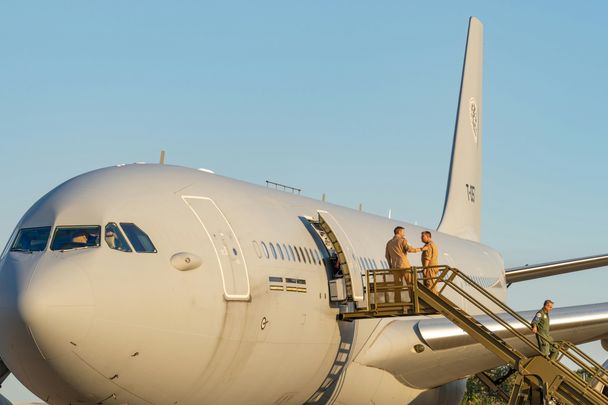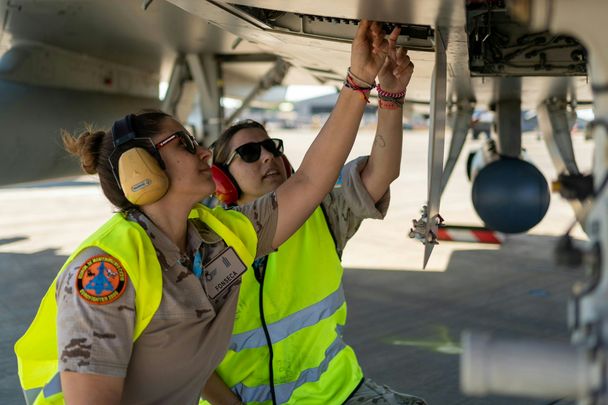Pitch Black 24: Logistics and maintenance as backbone of a seamless military exercise

More than 13,000 kilometres separate Europe and northern Australia. Over the course of three weeks, 20 nations took part in the Pitch Black exercise – a highly demanding scenario in which aircraft flew every day with the aim of strengthening international relationships, improving regional security and increasing resilience to transnational threats.
Over the course of several months, a great deal of work has been done in the shadows, from a logistical, maintenance and, of course, human point of view.

Going Down Under
With air forces from all over the world taking part in Pitch Black, getting equipment and personnel Down Under was a huge logistical task in itself. The French, Spanish, German and Malaysian air forces all relied on the A400M, mainly to transport spare parts for their fighter jets, as well as personnel. As Felix, an A400M pilot with the German Air Force puts it: “We mainly took care of the logistics in the background. For example, a Eurofighter does not have a cargo hold to transport spare parts, so we brought them in advance or when they were needed.”
Likewise, the A330 MRTT was used in this context. France, Singapore, the United Kingdom and the German-led Multinational MRTT Unit all counted on the aircraft for logistical support in addition to its primary tanker role.

Eurofighter 100-hour inspection
On the ground it was up to people like Brigadier Fonseca to ensure that the aircraft were up and running. She is a Eurofighter mechanic with the Spanish Air and Space Force and responsible for carrying out inspections on the fighter jet - from the most superficial, once the aircraft reaches 25 hours, to the most detailed, up to 2,000 hours.
“We came mainly to do a 100-hour inspection, which was pretty laborious,” she explains. “We had to lift the plane on jacks and put it in the hangar. It took several people.” The service included the inspection of visual and functional elements that could prevent the aircraft from flying. One of the main difficulties faced by the mechanics was the distance from Europe, with its limitations in terms of personnel and equipment, as well as an unfamiliar climate.
“The work was a bit different because of the long flight times we had, the temperatures and the winds,” says Dennis, an A400M technician from the German Air Force. “There was also a lot of sand in the air.”

Crossed maintenance: reduction of the logistical footprint
Faced with these complexities, Germany and Spain had signed agreements to support each other in case certain equipment was needed or an aircraft broke down.
“This greatly reduced the footprint, both in terms of material and personnel,” explains major Fernando, a Eurofighter pilot with the Spanish Air and Space Force. “For example, German mechanics were authorised to repair an issue on a Spanish Eurofighter with a Spanish mechanic present who checked that the action taken was in accordance with national standards.”
This came to bear before Pitch Black started: In Alaska, a Spanish Eurofighter developed an engine problem and was unable to fly. After the necessary approvals and compatibility checks, it was replaced by a German one and continued its journey to Australia via Japan.
Germany and Spain collaborating, is nothing new. The two countries also joined forces when it came to maintenance during air policing in the Baltics, protecting NATO's eastern flank.

Franco-Australian A330 MRTT cooperation
Meanwhile, a French A330 MRTT was struck by lightning on a flight to Australia. A thorough analysis revealed that a vital tool for checking the frequency of the in-flight refuelling boom was missing. Arriving at Amberley Air Base in Western Australia, the French mechanics were joined by their Australian counterparts and together they solved the problem.
Meanwhile, a French A330 MRTT was struck by lightning on a flight to Australia. A thorough analysis revealed that a vital tool for checking the frequency of the in-flight refuelling boom was missing. Arriving at Amberley Air Base in Western Australia, the French mechanics were joined by their Australian counterparts and together they solved the problem.“Everything was ready for us when we arrived in Australia,” says Lieutenant Florence, head of technical support for the French A330 MRTT detachment. “We were immediately able to retrieve our equipment without quarantine and were given a storage area with the other air forces participating in the exercise.”
All this exemplifies the great level of collaboration, combined with excellent logistics and a high level of preparedness that allowed European air forces to anticipate problems and resolve them efficiently when they arose. It played a huge role in making Pitch Black a success, enabling the European participants to strengthen alliances between each other and with the countries of the Pacific.



